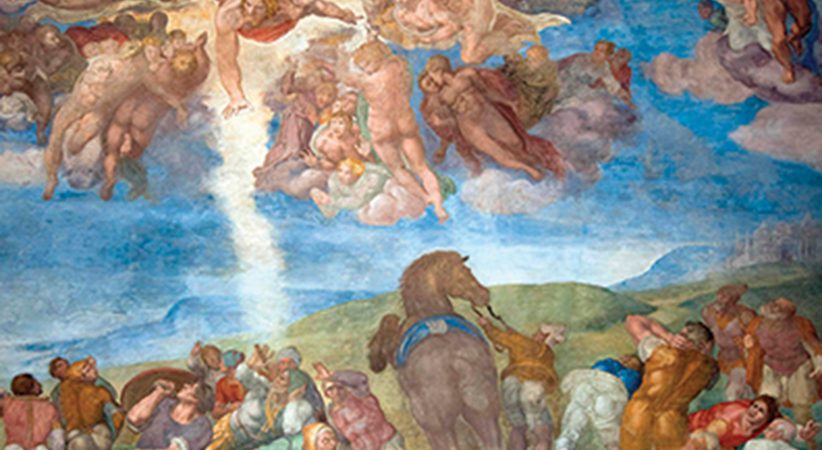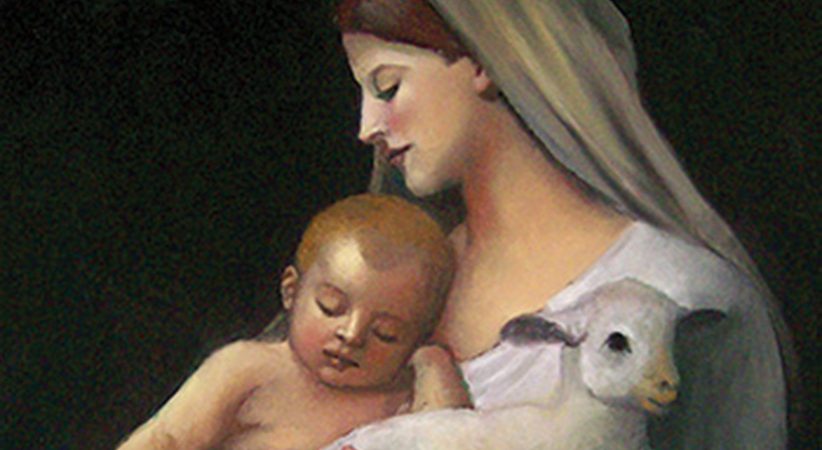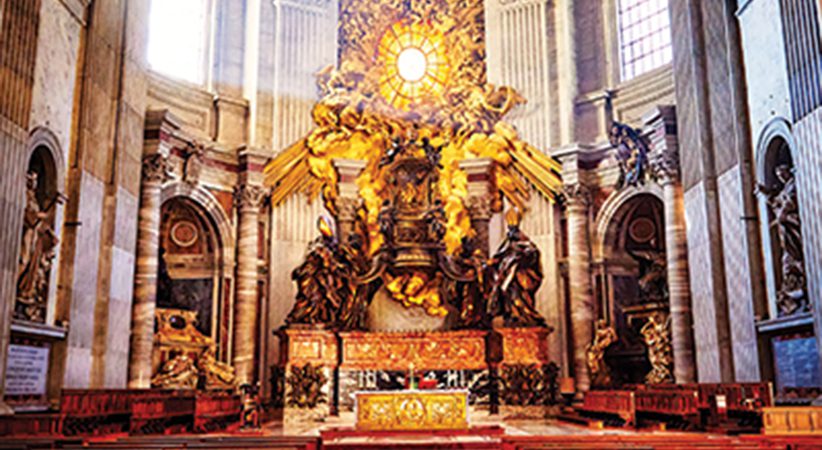Promoting Church Missions
Transmission and dissemination of the Gospel to the multitudes
D.D. Emmons Comments Off on Promoting Church Missions
According to the documents of the Second Vatican Council (1962-65), proclaiming the Gospel of Jesus Christ to the whole world, is the “greatest and holiest task” of the Church (cf. Ad Gentes, No. 29). This missionary responsibility has gone unchanged for 2,000 years; today, Christians constitute only about one-third of world religions, so the need for missionaries to share the sacred message of Our Savior continues.
In his 1990 encyclical, Redemptoris Missio, Pope St. John Paul II (r. 1978-2005) wrote, “This [missionary activity] is one of the Church’s fundamental actions: it is essential and never-ending. The Church, in fact, ‘cannot withdraw from her permanent mission of bringing the Gospel to the multitudes — the millions and millions of men and women — who as yet do not know Christ the Redeemer of humanity’” (No 31).
In March of this year, Pope Francis underscored this primary task of the Church in his apostolic constitution Praedicate Evangelium, in which he reorganized the Vatican Curia, creating the Dicastery of Evangelization. This papal constitution takes effect June 2022.
Dicastery of Evangelization
The universal missionary effort of the Catholic Church is orchestrated by the Vatican Dicastery of Evangelization. For more than 350 years, this dicastery was called the Congregation for the Propagation of the Faith, or simply, Propaganda Fide. As a result of a 1967 Curia reorganization, it became known as the Congregation for the Evangelization of Peoples (CEP). With the issuance of Praedicate Evangelium, and the subsequent reshaping of the Curia, CEP was merged with the Pontifical Council for Promoting the New Evangelization, and the combined agencies were named the Dicastery of Evangelization.
While only limited organizational and personnel details were available at the time of this writing, the dicastery will be made up of two sections: one called “Section for the fundamental questions of evangelization in the world” with responsibilities that generally encompasses defining effective ways to encourage evangelization, serving and supporting efforts by particular Churches to spread the Gospel among people in every culture, including the fallen away, and identifying and disseminating best catechesis methods. The other section, “Section for the first evangelization and the new particular Churches,” focuses on the territories of its competence and is responsible for the grassroots missionary efforts enjoyed by the CEP.
In an unusual move, the pope will assume the role of prefect for this two-section dicastery with each section led by a pro-prefect reporting to the pope. By taking on the role and merging the two agencies, the pope is signaling to the world, reminding every Catholic, that the basic mission of the Church is to evangelize the message of Jesus Christ, to articulate the Good News to every person in every land.
Early Missionary Formation
By the 17th century, European explorers were increasingly discovering new lands and new people, especially in the Americas, Asia and Africa. In most cases, the people in these newly explored lands had never heard of Jesus, and Catholic missionaries were soon to bring the Good News to the native inhabitants. Some of the first missionaries were men and later women who would give their lives.
During this period, the Catholic Church was also beginning a revolution to counter the Protestant Reformation of the 16th century. Not a small part of the Church’s missionary effort was dedicated to bringing back to the Catholic Faith those who had left for Protestantism. Consequently, there was a continuous need for missionaries both in foreign lands and in Europe. To better control and organize this ongoing movement, a single Church entity was created in 1622 by Pope Gregory XV (r. 1621-23) through his papal bull Inscrutabili Divinae. This Church entity, known at the time as the Congregation for the Propagation of the Faith, or Propaganda Fide, was charged with coordinating and directing the missionary activity of the Church.
To facilitate this expanding evangelization program, there was an increasing need for proper training of missionaries. As far back as the Council of Nicea in 325, the Church was concerned about the brevity of instruction for those being selected to become evangelists or priests. The first Vatican-institutionalized training was created by Pope Urban VIII (r. 1623-44) in 1627, who oversaw the development of a school in Rome, called the Pontifical Urban College, that gave special attention to the missionary role of the Church. The students were initially Europeans, but soon the need was so great that men native to the different mission countries were brought to Rome for education, including priestly ordination.
Later, the Church, and Pope Benedict XV (r. 1914-22), realized that teaching the Gospel and expanding the role of the Church was best attained through the natives of lands where there was a Catholic mission, “Anyone who has charge of a mission … must make it his special concern to secure and train local candidates for the sacred ministry” (Maximum Illud, No. 14).
Support for Evangelization
Current methods for supporting the CEP, and in turn the missions, were spelled out in a June 1988 apostolic constitution, Pastor Bonus, issued by Pope St. John Paul II. The document reads: “To foster missionary cooperation, even through the effective collection and equal distribution of subsidies, the congregation chiefly uses the Pontifical Missionary Works, namely the Society for the Propagation of the Faith, the Society of St. Peter the Apostle, and the Missionary Childhood Association, as well as the Pontifical Missionary Union of the Church” (Article 91).
Pope Francis’ Praedicate Evangelium renews this arrangement and entrusts the Pontifical Mission Societies to the section for the evangelization and the new particular Churches (cf. Art. 67).
These Pontifical Missions evolved beginning in the early 19th century:
The Society for the Propagation of Faith was created by Venerable Pauline Jaricot in 1822. Pauline’s initial idea was to raise funds and provide financial assistance for the French foreign missions. Today every Catholic has the opportunity to become a member of this highly successful society and provide financial contributions to support worldwide missionary needs, especially for the Church in Africa, Asia, the Pacific Islands and parts of Latin America.
The Pontifical Society of the Missionary Childhood Association provides a variety of assistance including education, medical and nutrition programs for more than 3 million children in Catholic missions. Founded in 1843 by Bishop Charles de Forbin-Janson, CPM, of Nancy, France, the program’s slogan is “children helping children.” Children outside the mission countries are educated about their contemporaries and encouraged to pray for and participate in ways to help, including financial support for children in those missions — again, “children helping children.”
The Society of St. Peter the Apostle, founded by two French women, Jeanne Bigard and her mother, Stephanie, in 1889, was to assist those men seeking to join the priesthood in places where the Church has missions — that is, to help them with the admissions process and financial needs. This program strives to put the individual in a position where he can apply for the priesthood and then subsidize his needs following ordination.
The intent of the Pontifical Missionary Union is to increase awareness of the Church missionary role among priests and religious, among religious education teachers and catechists, to inspire them to become missionaries, and to encourage those in the program to continue their work. The union was founded in 1916 by Blessed Paolo Manna, whose goal was to educate the Church faithful on the work of the missions and the missionaries.
In addition to the Pontifical Missions, every Catholic diocese has a ministry to coordinate, promote and support the missionary role of the CEP. These ministries are successful in educating and uniting the faithful in prayer and in the collection of needed funds for the missions.
World Mission Sunday
Throughout the universal Church, the next to last Sunday every October is designated as World Mission Sunday. The intent is for Catholics everywhere to celebrate and pray for missions and missionaries. The single biggest fundraiser for the CEP missionary effort also takes place on that Sunday. Every Catholic has the opportunity to contribute to the missionary programs through a parish-level special collection. The annual average amount annually collected in the United States is $50 million. World Mission Sunday has been taking place with encouragement by every pope since 1926. Pope Francis issued his 2022 World Mission Sunday message by telling the faithful, “I continue to dream of a completely missionary Church, and a new era of missionary activity among Christian communities” (No. 3).
2022 — Special Year for the Church Missionary Role
The year 2022 will highlight several significant events in the long history, albeit by different names, of the Dicastery for Evangelization and the four Pontifical Mission Societies: the CEP celebrates its 400th anniversary; this year marks 200 years since the inception of the Society of the Propagation of Faith, and on May 22 its founder, Pauline Jaricot, was beatified; it has been 100 years since the Society for the Propagation of Faith, the Missionary Childhood Association and the Society of St. Peter the Apostle were designated Pontifical; and 2022 is the 150th anniversary of the birth of Blessed Paolo Manna founder of the Pontifical Mission Union.
D.D. EMMONS writes from Pennsylvania.
………………………………………………………………………………………………………………………………………………………
Vatican II and the Dicastery for Evangelization
The Second Vatican Council made clear the Church’s missionary role: “The pilgrim Church is missionary by her very nature, since it is from the mission of the Son and the mission of the Holy Spirit that she draws her origin, in accordance with the decree of God the Father” (Ad Gentes, No. 2).
In regard to the role of the Dicastery for Evangelization, Vatican II bishops also wrote: “For all missions and for the whole missionary activity, there should be one competent office, namely that of the ‘Propagation of Faith,’ [today known as the Dicastery for Evangelization] which should direct and coordinate throughout the world, both missionary work itself and missionary cooperation. …
“This office should promote missionary vocations and missionary spirituality, zeal and prayer for the missions, and should put out authentic and adequate reports about them. Let it raise up missionaries and distribute them according to the most urgent needs of various areas. Let it arrange for an orderly plan of action, issue directives and principals adapted to evangelization and give the impetus. Let it take care of stimulating and coordinating effective collection of funds, which are distributed according to reasons of necessity and usefulness” (No. 29).
…………………………………………………………………………………………………………………………………………………………





